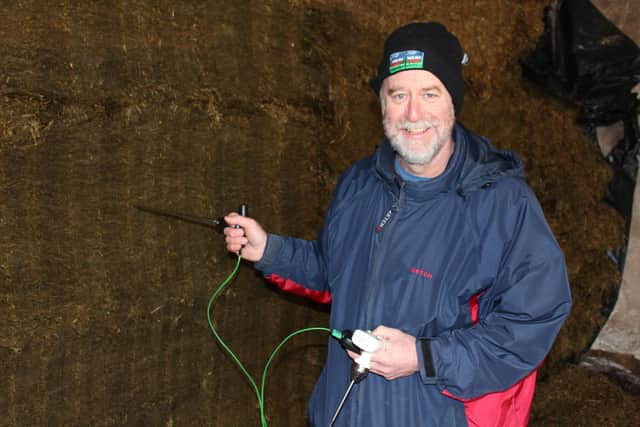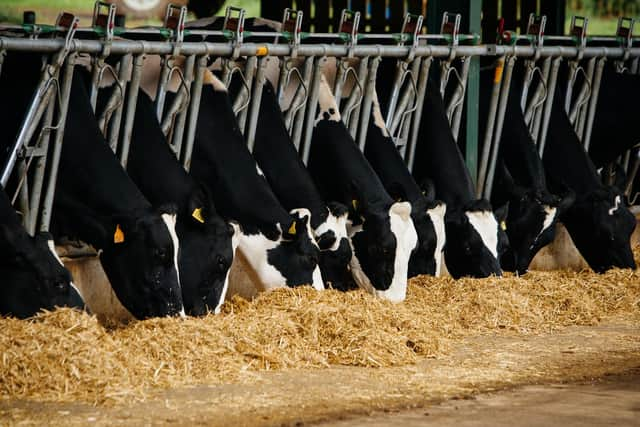Have you met your silage-making targets for 2022?
and live on Freeview channel 276
From the outset, he posed the fundamental question to the many people attending the event: Have you met your silage-making targets for 2022?
He followed this up with: If not, why not?
According to the renowned forage scientist, the following targets should be set for the production of grass silage in any year:


Dry matter — 30%
ME — 11.5–12.0
Crude protein — 14%+
Advertisement
Advertisement
However, he went on to make the point that it is possible to push protein levels significantly above the generally accepted 14% threshold, possibly up to 16%.


Davies further explained:
“By having the higher protein target, we are more likely to hit the more generally accepted specification.”
Davies then discussed the results of the 2022 Alltech silage survey for the island as a whole. Starting with dry matters, he confirmed that the average figure is coming in at around 30%, adding.
“This is bang on target. However, there are very wide variations within this. The lowest dry matter figure comes in at 18%, with the highest value recorded at 70%.
Advertisement
Advertisement
“I am assuming that this latter figure relates to baled silages.”
According to Davies, it is important to assess the average figures at the top and bottom of the dry matter scales.
He added:“The top 10% of silages have an average dry matter figure of 50%. Again, it is to be expected that these represent baled silages.
“However, the bottom 10% of silages analysed are averaging a dry matter figure that is below 20%.
Advertisement
Advertisement
“This will constitute a huge challenge for the relevant farms, in many respects.”
The forage scientists went on to point out that overall silage analysis results become more inaccurate as dry matters start to decrease.
“More importantly are the crude protein and ME results. The Alltech survey confirms an average Crude Protein figure of 12% and an ME value of 10.5 for the island of Ireland s a whole,” he commented.
“Both figures are below target levels. But it is well worth looking at the range of results. These confirm that the top 10% of Irish farmers have met their crude protein and ME targets in 2022.
Advertisement
Advertisement
“So this means we are setting targets that are achievable. And, of course, this has a major impact on the levels of animal performance that can be achieved from forages.”
Davies then reflected on a number of dairy cow trials carried out at AFBI Hillsborough a number of years ago. This work entailed the making of silage in the same field 15 to 18 days apart. The D value of the forages differed significantly: 73 versus 62.
Moreover, when the silages were offered to cows, the milk yield difference amounted to 2.6L/day.
“So this is why we keep talking about the need to set targets for silage making,” Davies stressed.
Advertisement
Advertisement
“Pushing milk from forage is vitally important: dairy cows are ruminant animals.”
The Wales-based consultant then discussed the factors that impact silage crude protein and ME values.
The maturity of grass at harvest is a critical issue in this regard.
He explained:“The starting point is the period between initial field closure and the date of first cut,” he said.
Advertisement
Advertisement
“The target should be cut before the start of the sixth week. The bulk of the ME value is determined by the digestibility of the NDF fraction within the grass.
“As lignin content within the grass increases, so do NDF digestibility and ME values.”
Davies also confirmed the link between ME and silage protein values.
He continued:“There is a clear linkage between ME and crude protein values as grass goes through its various growth stages.
Advertisement
Advertisement
“But in the real world, other factors come into play. This is apparent in the 420 silages analysed by Alltech this year.
“Basically, we can see that there are a significant number of factors impacting on crude protein levels, apart from the digestibility of the grass and the maturity of the crop.
“It is clearly evident that numerous forages with the same ME values have different protein values.”
In explaining these differences, Davies pointed to the fact that nutrient management programmes implemented while growing grass crops will have a fundamental influence on subsequent silage quality.
Advertisement
Advertisement
He added:“This has been a challenging year in terms of fertiliser prices. This challenge is going to increase as the season progresses. So it is an issue that we will have to keep a key focus on.
“Research work has consistently confirmed the linkage between added fertiliser nitrogen and silage protein values.
“This is a factor that farmers must take full account of as they look forward to 2023. Another key grass nutrient is sulphur. It is critically important in allowing grass to synthesise specific amino acids and proteins.
“If sulphur is not available in sufficient quantities, growth rates will be reduced. And this is another important issue that farmers will have to take account of as they consider their fertiliser options for the year ahead.
Advertisement
Advertisement
“Other factors that impact on silage energy values and protein contents are the harvesting-related dry matter and organic matter losses.
“These values are impacted by wilting times and the management of the forage from ensiling through to feed out.”
Davies went on to question the long-accepted wisdom of cutting in the afternoon, when grass sugar levels are at their highest values. A 24-hour wilt would then follow.
“Yes, sugar levels are at their highest in the afternoon period,” he added.
Advertisement
Advertisement
“But this is not really the issue. Making good silage is all about conserving the nutrients in the grass.
“Research has shown that grass left to wilt overnight will lose a high proportion of its nutrient value.
“Wilting to get grass down to a 30% dry matter value as quickly as possible is important.
“While leaf stomata are open, grass can lose up to 100L of water per tonne of grass per hour. However, when the stomata close, this figure drops to 20L.
Advertisement
Advertisement
“Stomata only stay open for a couple of hours after mowing. So we need to spread the crop immediately after cutting, irrespective of the weather conditions.
“This means that the bulk of wilting takes place in the period directly after mowing. A study carried out in Wales has confirmed that rapid wilting will minimise ME losses, while a further study in Devon confirms that rapid wilting will act to reduce protein losses."
According to the silage specialist, farmers must control the nutrient losses from grass. Crucial to this is the need to wilt as rapidly as possible.
He commented:“So cutting at 10.00a.m., and then pushing for as rapid a wilt thereafter, will help to maintain the protein values and other key nutrient parameters in grass that is made into silage.”
Advertisement
Advertisement
Clamp management is also key in maximising the nutritive value of grass silage. Here Davies recommends the use of homo-fermentative only additives in order to control the breakdown of nutrients.
He further explained:“Hetero-fermentative bacteria will deliver a more inefficient fermentation, taking longer to get the pH of the silage down to the required value.”
“When we think about silage, it is the acid in the liquid phase that controls the fermentation.
“Lower dry matter silages contains more water. So, greater quantities of acid will be required to drop the pH.
Advertisement
Advertisement
“Lactic is almost eight times stronger acid than is the case with acetic acid, which is produced during a hetero-fermentative ensiling process.
“The quicker a pH value of 4.0 is reached within a clamp, the greater the level of true protein and sugars that are maintained within the forage.”
Davies concluded:“It’s important to make the clamp anaerobic as quickly as possible. This entails good clamp management, the use of sheeting, the use of cling film, an oxygen barrier, top sheet and sufficient top weight.
“If we do all that, we allow a good fermentation to take place.
Advertisement
Advertisement
“We will maximise the retention of protein and sugars, which will optimise the nutritive value of the silage at feed out.
“The sealing of the clamp is very important. It keeps oxygen out. But, more important than this, it also keeps carbon dioxide in.
“Carbon dioxide is the additive that is available for free as it acts to reduce degradative processes within the clamp.”
The second speaker of the evening was Alltech’s European technical manager - ruminants, Dr Helen Warren.
Advertisement
Advertisement
Courtesy of her presentation, she highlighted the myriad benefits that can be accrued through the inclusion of Optigen® in Total Mixed Ration (TMR) diets.
The product is an innovative feed ingredient that provides a controlled release of non-protein nitrogen (NPN) to the rumen over time.
This ensures that rumen bacteria have continued access to this essential food source, leading to an increase in microbial protein, fibre digestion and available energy for milk and meat production.
She explained:“We know now that Irish silages made this year are low in both protein and energy. So a feeding priority for the winter ahead will be to maintain protein levels in feed but also to derive more energy from the same diets.”
Advertisement
Advertisement
Warren went on to confirm that excessive protein in the cow’s diet will have a detrimental impact on the efficiency of her milk output and subsequent fertility-related performance.
She continued: “Stabilising ammonia levels in the rumen is critically important in determining the overall level of protein efficiency achieved by the cow.
“We are trying to get higher levels of fibre utilisation within the diet. The bacteria responsible for these processes are highly dependent on available ammonia.
“So, we want to avoid a period of excess and deficiency in this regard.
Advertisement
Advertisement
“Optigen® can be used very efficiently to meet this requirement. As the product is a very concentrated form of available nitrogen, its use allows for a reduction in vegetable protein sources within ruminant diets. In turn, this provides space for more energy-dense feeds in rations.”
As a protein source, Optigen® is comparable to soya. The protein is broken down at a similar rate, while it works more in the rumen and acts to boost the rumen population of those microbes that specifically break down fibre.
Research carried out at Harper Adams University has confirmed that the inclusion of Optigen in diets will increase both overall digestibility and nitrogen utilisation.
Physical evidence to this effect can be discerned at farm level. The manure of the animals on Optigen will have significantly fewerundigested grains andlonger fibre.
Advertisement
Advertisement
In other words, the animals are getting much more out of the diets on offer to them.
Along with performance benefits, Optigen also contributes to the overall sustainability of a cattle feeding process.